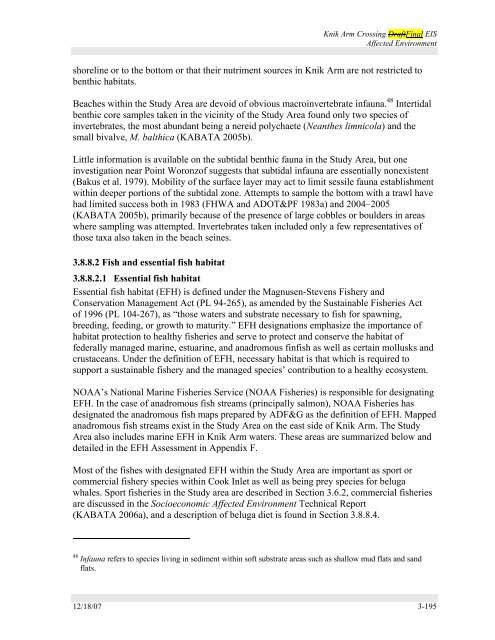3.0 Affected Environment - Knik Arm Bridge and Toll Authority
3.0 Affected Environment - Knik Arm Bridge and Toll Authority
3.0 Affected Environment - Knik Arm Bridge and Toll Authority
You also want an ePaper? Increase the reach of your titles
YUMPU automatically turns print PDFs into web optimized ePapers that Google loves.
<strong>Knik</strong> <strong>Arm</strong> Crossing DraftFinal EIS<br />
<strong>Affected</strong> <strong>Environment</strong><br />
shoreline or to the bottom or that their nutriment sources in <strong>Knik</strong> <strong>Arm</strong> are not restricted to<br />
benthic habitats.<br />
Beaches within the Study Area are devoid of obvious macroinvertebrate infauna. 48 Intertidal<br />
benthic core samples taken in the vicinity of the Study Area found only two species of<br />
invertebrates, the most abundant being a nereid polychaete (Neanthes limnicola) <strong>and</strong> the<br />
small bivalve, M. balthica (KABATA 2005b).<br />
Little information is available on the subtidal benthic fauna in the Study Area, but one<br />
investigation near Point Woronzof suggests that subtidal infauna are essentially nonexistent<br />
(Bakus et al. 1979). Mobility of the surface layer may act to limit sessile fauna establishment<br />
within deeper portions of the subtidal zone. Attempts to sample the bottom with a trawl have<br />
had limited success both in 1983 (FHWA <strong>and</strong> ADOT&PF 1983a) <strong>and</strong> 2004–2005<br />
(KABATA 2005b), primarily because of the presence of large cobbles or boulders in areas<br />
where sampling was attempted. Invertebrates taken included only a few representatives of<br />
those taxa also taken in the beach seines.<br />
3.8.8.2 Fish <strong>and</strong> essential fish habitat<br />
3.8.8.2.1 Essential fish habitat<br />
Essential fish habitat (EFH) is defined under the Magnusen-Stevens Fishery <strong>and</strong><br />
Conservation Management Act (PL 94-265), as amended by the Sustainable Fisheries Act<br />
of 1996 (PL 104-267), as “those waters <strong>and</strong> substrate necessary to fish for spawning,<br />
breeding, feeding, or growth to maturity.” EFH designations emphasize the importance of<br />
habitat protection to healthy fisheries <strong>and</strong> serve to protect <strong>and</strong> conserve the habitat of<br />
federally managed marine, estuarine, <strong>and</strong> anadromous finfish as well as certain mollusks <strong>and</strong><br />
crustaceans. Under the definition of EFH, necessary habitat is that which is required to<br />
support a sustainable fishery <strong>and</strong> the managed species’ contribution to a healthy ecosystem.<br />
NOAA’s National Marine Fisheries Service (NOAA Fisheries) is responsible for designating<br />
EFH. In the case of anadromous fish streams (principally salmon), NOAA Fisheries has<br />
designated the anadromous fish maps prepared by ADF&G as the definition of EFH. Mapped<br />
anadromous fish streams exist in the Study Area on the east side of <strong>Knik</strong> <strong>Arm</strong>. The Study<br />
Area also includes marine EFH in <strong>Knik</strong> <strong>Arm</strong> waters. These areas are summarized below <strong>and</strong><br />
detailed in the EFH Assessment in Appendix F.<br />
Most of the fishes with designated EFH within the Study Area are important as sport or<br />
commercial fishery species within Cook Inlet as well as being prey species for beluga<br />
whales. Sport fisheries in the Study area are described in Section 3.6.2, commercial fisheries<br />
are discussed in the Socioeconomic <strong>Affected</strong> <strong>Environment</strong> Technical Report<br />
(KABATA 2006a), <strong>and</strong> a description of beluga diet is found in Section 3.8.8.4.<br />
48 Infauna refers to species living in sediment within soft substrate areas such as shallow mud flats <strong>and</strong> s<strong>and</strong><br />
flats.<br />
12/18/07 3-195
















